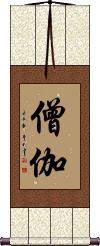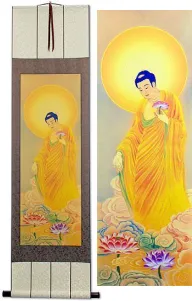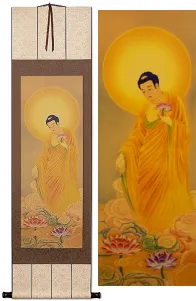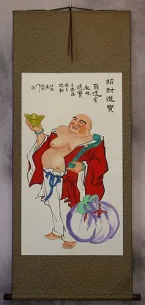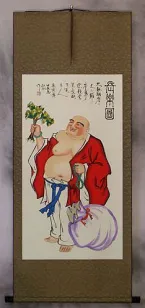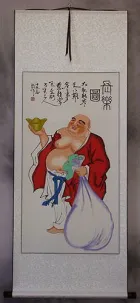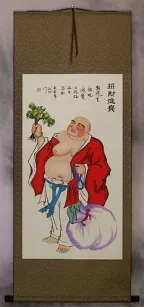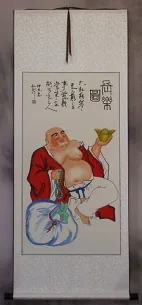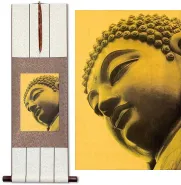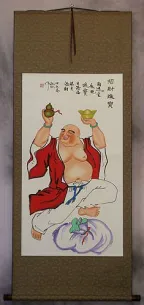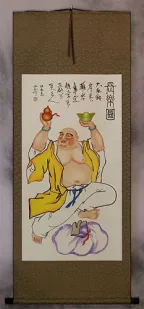Many custom options...
And formats...

Buddha Shakyamuni in Chinese / Japanese...
Buy a Buddha Shakyamuni calligraphy wall scroll here!
Personalize your custom “Buddha Shakyamuni” project by clicking the button next to your favorite “Buddha Shakyamuni” title below...
Shakyamuni / The Buddha
釋迦牟尼 is a transliteration of “Shakyamuni” or “Sakyamuni” in Chinese, Japanese, and old Korean.
The perceived meaning of the name is roughly translated as “Sage of the Sakyas.”
This same Buddha is also known as “Siddhartha Gautama,” “Gotama Buddha,” “Tathagata,” or simply, “The Supreme Buddha.”
Shakyamuni is the legendary man and prince who eventually established the Buddhist religion.
Note: Occasionally Romanized as “Siddhattha Gotama.”
This combination of characters is sometimes seen and used in South Korea and Japan as well (with the same meaning).
Note: 釋迦牟尼 came from the Sanskrit शाक्यमुनि and can also be romanized with diuretics as Śākyamuni.
Shakyamuni / The Buddha
釈迦 is the way to write Shakyamuni in Japanese.
It's just two Kanji, the first is a simplified version of the one used in Chinese for Shakyamuni, and the second one is identical to the Chinese.
This refers to the Buddha (Siddhartha Gautama, 563 BCE-483 BCE) also known as Sakyamuni and Gautama Buddha.
This has a very good meaning in Japanese but is an odd selection for a wall scroll. It appears here more for reference.
Namo Shakyamuni Buddha
南無釋迦牟尼佛 is a Buddhist chant or prayer of respect to the Shakyamuni Buddha.
Some will translate this as the Buddhist vow.
The first two characters, 南無, are sometimes translated as “amen”; others will translate it as “belief in” or “homage to.”
To expand on this, 南無 can also mean “taking of refuge in” while representing devotion or conviction. 南無 as with most religious concepts or words, different people or denominations will have varying definitions.
Siddhartha
悉達多 is the name Siddhartha (as in Siddhartha Gautama), the personal name for Śākyamuni.
This same Buddha is also known as “Shakyamuni Gautama,” “Gotama Buddha,” or “Tathagata.”
Siddhartha Gautama was a spiritual teacher in the northern region of the Indian subcontinent who founded Buddhism. He is generally seen by Buddhists as the Supreme Buddha (Sammāsambuddha) of known human history.
The actual meaning of this name in Chinese is the realization of all aims, or simply being prosperous.
This name is sometimes romanized from the original Sanskrit or Pali as Siddhattha (from Siddhattha Gotama), Siddharth, Siddhārtha, or Sarvāthasiddha.
Siddhārtha or Sarvāthasiddha can also be written as 悉達, 悉多, 悉多頞他, or 悉陀.
Sangha
In Buddhism, 僧伽 refers to a community of monks and/or nuns (one of the “Three Jewels”). In general terms, it can simply mean “all followers of the Buddha.”
Notes: Though there are not vast numbers of Chinese Hindus, in the Hindu faith, this term means “community together.”
The original Sanskrit word is also Romanized as samgha.
The first character means “monk.” The second character means Buddha or Shakyamuni.
僧伽 is a transliteration of the original Sanskrit, but it uses two very profound Chinese characters related to Buddhism.
Some may pronounce this as “seng qie” or “seng jia” in Mandarin (two possible pronunciations for the second character). Note that “qie” sounds like “chee-ah” using typical English pronunciation. Chinese Romanization is not actually designed to match English sounds.
![]()
![]() Note that when writing this as Kanji, Japanese will tend to write the first character in the form shown to the right. If you select our Japanese master calligrapher, please expect this special Kanji form. However, it should also be noted that this is not a common term in Japanese (except by certain sects of Buddhism or perhaps devout Buddhists in Japan).
Note that when writing this as Kanji, Japanese will tend to write the first character in the form shown to the right. If you select our Japanese master calligrapher, please expect this special Kanji form. However, it should also be noted that this is not a common term in Japanese (except by certain sects of Buddhism or perhaps devout Buddhists in Japan).
This in-stock artwork might be what you are looking for, and ships right away...
Gallery Price: $200.00
Your Price: $69.88
Gallery Price: $200.00
Your Price: $69.88
Gallery Price: $200.00
Your Price: $69.88
Gallery Price: $200.00
Your Price: $69.88
Not the results for buddha shakyamuni that you were looking for?
Below are some entries from our dictionary that may match your buddha shakyamuni search...
| Characters If shown, 2nd row is Simp. Chinese |
Pronunciation Romanization |
Simple Dictionary Definition |
釈迦 see styles |
shaka しゃか |
More info & calligraphy: Shakyamuni / The Buddha |
釋迦牟尼 释迦牟尼 see styles |
shì jiā móu ní shi4 jia1 mou2 ni2 shih chia mou ni Shakamuni |
More info & calligraphy: Shakyamuni / The Buddha釋迦文 (釋迦文尼); 釋伽文 Śākyamuni, the saint of the Śākya tribe. muni is saint, holy man, sage, ascetic monk; it is: intp. as 仁 benevolent, charitable, kind, also as 寂默 one who dwells in seclusion. After '500 or 550' previous incarnations, Śākyamuni finally attained to the state of Bodhisattva, was born in the Tuṣita heaven, and descended as a white elephant, through her right side, into the womb of the immaculate Māyā, the purest woman on earth; this was on the 8th day of the 4th month; next year on the 8th day of the 2nd month he was born from her right side painlessly as she stood under a tree in the Lumbinī garden. For the subsequent miraculous events v. Eitel. also the 神通遊戲經 (Lalitavistara), the 釋迦如來成道記, etc. Simpler statements say that he was born the son of Śuddhodana, of the kṣatriya caste, ruler of Kapilavastu, and Māyā his wife; that Māyā died seven days later, leaving him to be brought up by her sister Prājapati; that in due course he was married to Yaśodharā who bore him a son, Rāhula; that in search of truth he left home, became an ascetic, severely disciplined himself, and finally at 35 years of age, under a tree, realized that the way of release from the chain of rebirth and death lay not in asceticism but in moral purity; this he explained first in his four dogmas, v. 四諦 and eightfold noble way 八正道, later amplified and developed in many sermons. He founded his community on the basis of poverty, chastity, and insight or meditation, ad it became known as Buddhism, as he became known as Buddha, the enlightened. His death was probably in or near 487 B.C., a few years before that of Confucius in 479. The sacerdotal name of his family is Gautama, said to be the original name of the whole clan, Śākya being that of his branch, v. 瞿, 喬.; his personal name was Siddhārtha, or Sarvārthasiddha, v. 悉. |
前仏 see styles |
zenbutsu ぜんぶつ |
(1) {Buddh} Buddha prior to Gautama; (2) {Buddh} (See 後仏) Gautama Buddha; Shakyamuni; (surname) Zenbutsu |
彌勒 弥勒 see styles |
mí lè mi2 le4 mi le miroku みろく |
Maitreya, the future Bodhisattva, to come after Shakyamuni Buddha (surname) Miroku Maitreya, friendly, benevolent. The Buddhist Messiah, or next Buddha, now in the Tuṣita heaven, who is to come 5,000 years after the nirvāṇa of Śākyamuni, or according to other reckoning after 4,000 heavenly years, i.e. 5,670,000,000 human years. According to tradition he was born in Southern India of a Brahman family. His two epithets are 慈氏 Benevolent, and Ajita 阿逸多 'Invincible'. He presides over the spread of the church, protects its members and will usher in ultimate victory for Buddhism. His image is usually in the hall of the four guardians facing outward, where he is represented as the fat laughing Buddha, but in some places his image is tall, e.g. in Peking in the Yung Ho Kung. Other forms are彌帝M075962; 迷諦隸; 梅低梨; 梅怛麗 (梅怛藥 or 梅怛邪); 每怛哩; 昧怛 M067070曳; 彌羅. There are numerous Maitreya sūtras. |
仏涅槃 see styles |
butsunehan ぶつねはん |
(1) {Buddh} the death of Shakyamuni Buddha; (2) (abbreviation) {Buddh} (See 仏涅槃忌) Buddhist service held on the day of Buddha's death (orig. 15th of the 2nd month, now 15th of the 3rd month) |
彌勒佛 弥勒佛 see styles |
mí lè fó mi2 le4 fo2 mi le fo Miroku butsu |
Maitreya; the Bodhisattva that will be the next to come after Shakyamuni Buddha Maitreya Buddha |
燃燈佛 燃灯佛 see styles |
rán dēng fó ran2 deng1 fo2 jan teng fo Nentō Butsu |
Dipamkara Buddha, the former Buddha before Shakyamuni Buddha and the bringer of lights Dīpaṃkara |
お釈迦様 see styles |
oshakasan おしゃかさん oshakasama おしゃかさま |
Buddha; Shakyamuni |
御釈迦様 see styles |
oshakasan おしゃかさん oshakasama おしゃかさま |
Buddha; Shakyamuni |
釈迦三尊 see styles |
shakasanzon しゃかさんぞん |
{Buddh} Shakyamuni triad; Gautama triad; image of Shakyamuni (Gautama) Buddha flanked by two attendants |
釈迦如来 see styles |
nikurube にくるべ |
Gautama Buddha; Shakyamuni; the historical Buddha (5th century BCE?); (surname) Nikurube |
釈迦牟尼 see styles |
shakamuni しゃかむに |
Gautama Buddha (san: Śākyamuni); Shakyamuni; the historical Buddha (5th century BCE?) |
お釈迦さん see styles |
oshakasan おしゃかさん |
Buddha; Shakyamuni |
Variations: |
hotoke(p); hotoke(sk) ほとけ(P); ホトケ(sk) |
(1) Buddha; Shakyamuni; (2) Buddhist image; figure of Buddha; (3) (also written as ホトケ) the dead; dead person; departed soul; (4) merciful person |
Variations: |
oshakasan おしゃかさん |
(See お釈迦様・おしゃかさま) Buddha; Shakyamuni; the historical Buddha (5th century BCE?) |
Variations: |
oshakasama おしゃかさま |
(See 釈迦・しゃか) Buddha; Shakyamuni; the historical Buddha (5th c. BCE?) |
Variations: |
oshakasama おしゃかさま |
(See 釈迦・しゃか) Buddha; Shakyamuni; the historical Buddha (5th century BCE?) |
The following table may be helpful for those studying Chinese or Japanese...
| Title | Characters | Romaji (Romanized Japanese) | Various forms of Romanized Chinese | |
| Shakyamuni The Buddha | 釋迦牟尼 释迦牟尼 | sha ka mu ni shakamuni | shì jiā móu ní shi4 jia1 mou2 ni2 shi jia mou ni shijiamouni | shih chia mou ni shihchiamouni |
| Shakyamuni The Buddha | 釈迦 | sha ka / shaka | shì jiā / shi4 jia1 / shi jia / shijia | shih chia / shihchia |
| Namo Shakyamuni Buddha | 南無釋迦牟尼佛 南无释迦牟尼佛 | namu shakamuni butsu namushakamunibutsu | nán wú shì jiā móu ní fó nan2 wu2 shi4 jia1 mou2 ni2 fo2 nan wu shi jia mou ni fo nanwushijiamounifo | nan wu shih chia mou ni fo nanwushihchiamounifo |
| Siddhartha | 悉達多 悉达多 | shiddatta / shiddaruta | xī dá duō xi1 da2 duo1 xi da duo xidaduo | hsi ta to hsitato |
| Sangha | 僧伽 | sougya / sogya | sēng qié / seng1 qie2 / seng qie / sengqie | seng ch`ieh / sengchieh / seng chieh |
| In some entries above you will see that characters have different versions above and below a line. In these cases, the characters above the line are Traditional Chinese, while the ones below are Simplified Chinese. | ||||
Successful Chinese Character and Japanese Kanji calligraphy searches within the last few hours...




